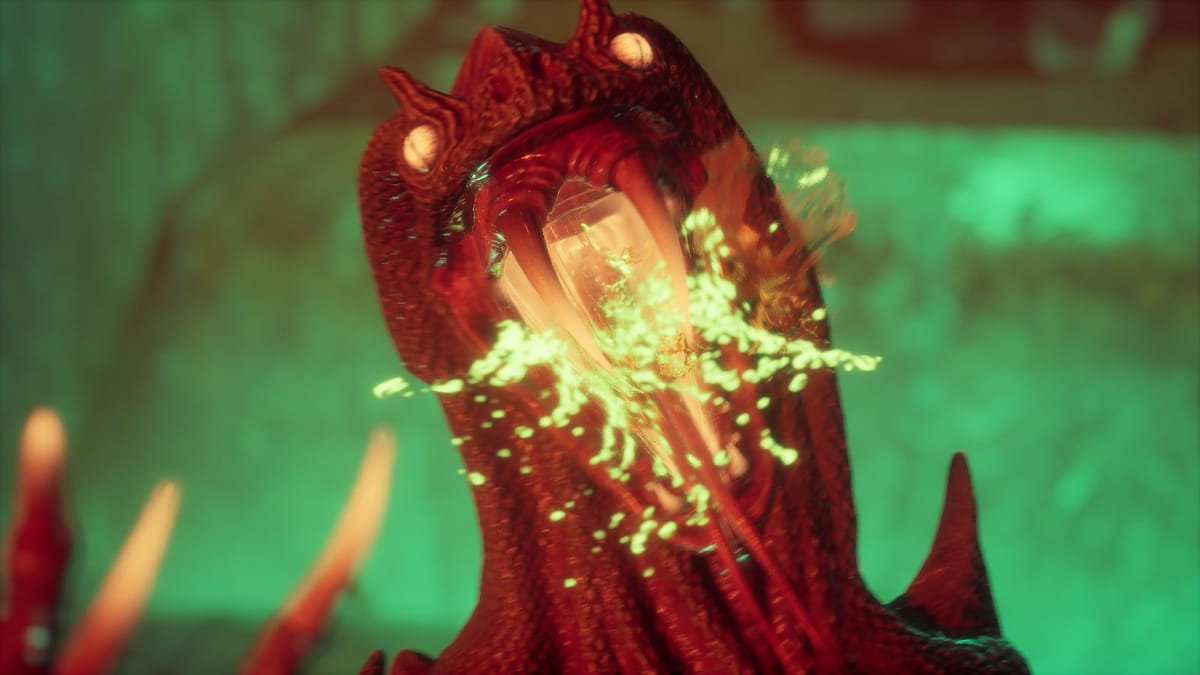
One thing I’ve learned from playing so many roguelikes and roguelites is that you need a killer core gameplay loop in order to keep players satisfied with their experience. Horizontal or vertical progression just won’t cut it. The enemies need to be interesting to fight, they need to feel responsive in combat, diverse in function, and most importantly, they need to feel good to smash. Perish has that gameplay loop, well, for the first half anyways…
You play as Amyetri (also known as “Pariah”) on a quest to escape from the underworld and reach Elysium. In order to break free, you need to make your way through various underworld-themed levels, taking on hellish mobs and bosses. The intro begins with Amytri breaking out of a stone coffin. I adore how the intro implies you’re on one of many, many attempts to escape, with countless coffins cracked open around you.
You start in the Pantheon, the home base where you buy weapons and equipment from the altar, but before you can do that, you need danake, money that you gain from killing your fiendish foes. There’s one way out of the Pantheon, and that’s through a massive golden portal in front of the altar. Entering starts your odyssey to ascension.
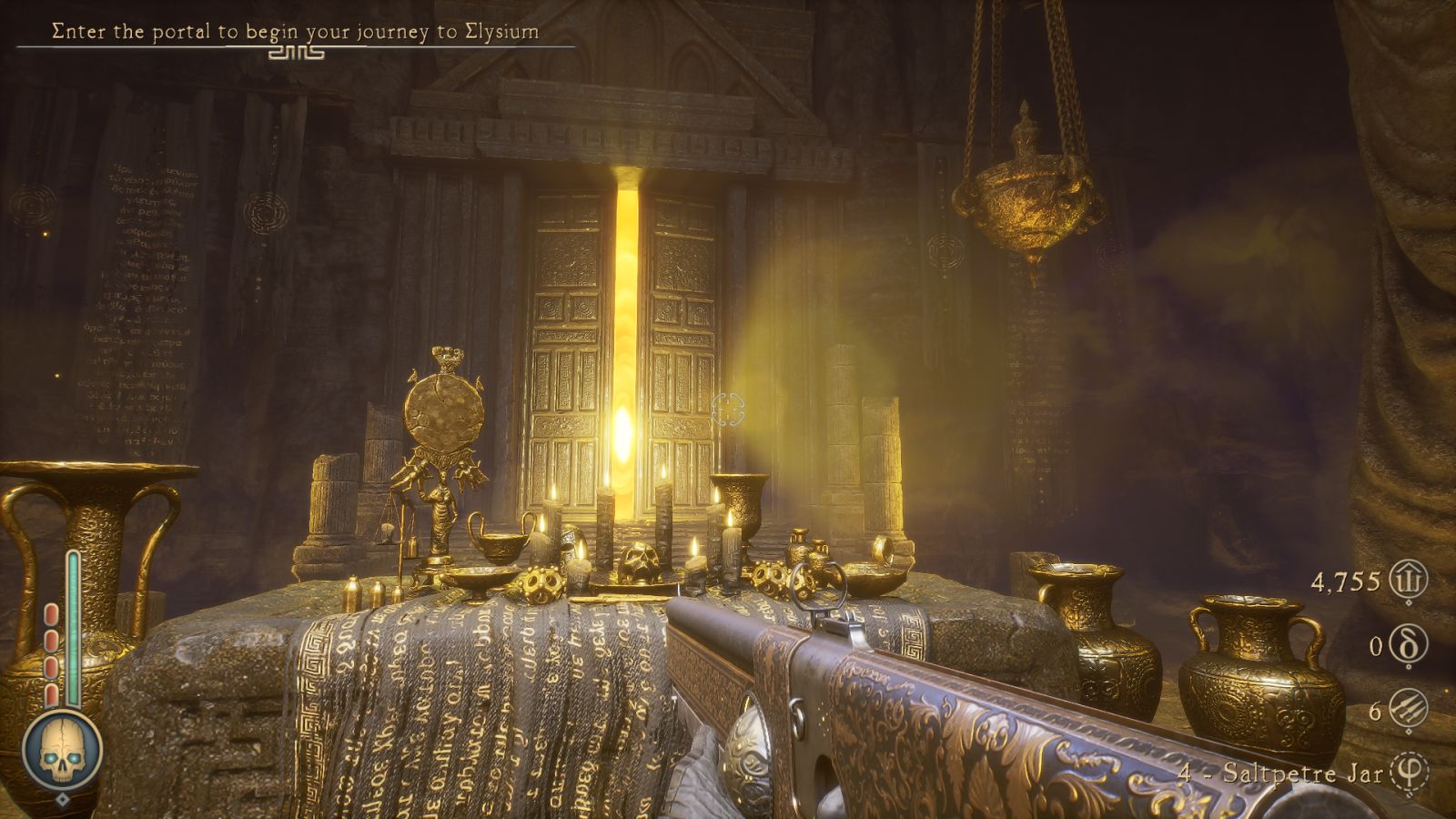
You know a game will be brutal when at the start, your only ally tells you, “Through the portal purgatory awaits, when you fail, return to me.” Not if you fail, when you fail. It’s not bluffing, three hits and you’re dead, back to the start, back to the Pantheon. With proper items and level-ups, you can get a whopping four health points and a shield for your last bit of health. I hope you’re good at dodging!
The basic melee mobs at the start of the game are simple yet effective. They all look like zombies and have some combination of spears, swords, and shields. Some enemies also have helmets and some have body armor. This simple variation adds more to the gameplay loop. You have to put just a little bit more thought into taking down the basic mobs. Early-game enemies just feel good to fight, and they feel even better to kill. They dodge your attacks when you aim at them, and get dismembered when you take them down.
You have a primary weapon and an unlimited supply of throwing knives, though the knives need to recharge for a few seconds after use. You also have a kick; it’s not super powerful, but it can knock enemies off of ledges or push them into traps. There was an absolutely brutal moment where I kicked an automaton into a swinging blade, which catapulted it into a wall of spikes. Blood and oil splattered the spikes as it let out a mechanical screech. It all felt… impactful. It’s also important to note that you have a swift dodge to whisk you away to safety, but it has a decent cooldown, so always remember the trinity: primary, kick, and throwing knife. Weave all three together and you should fend off the basic mobs with ease.
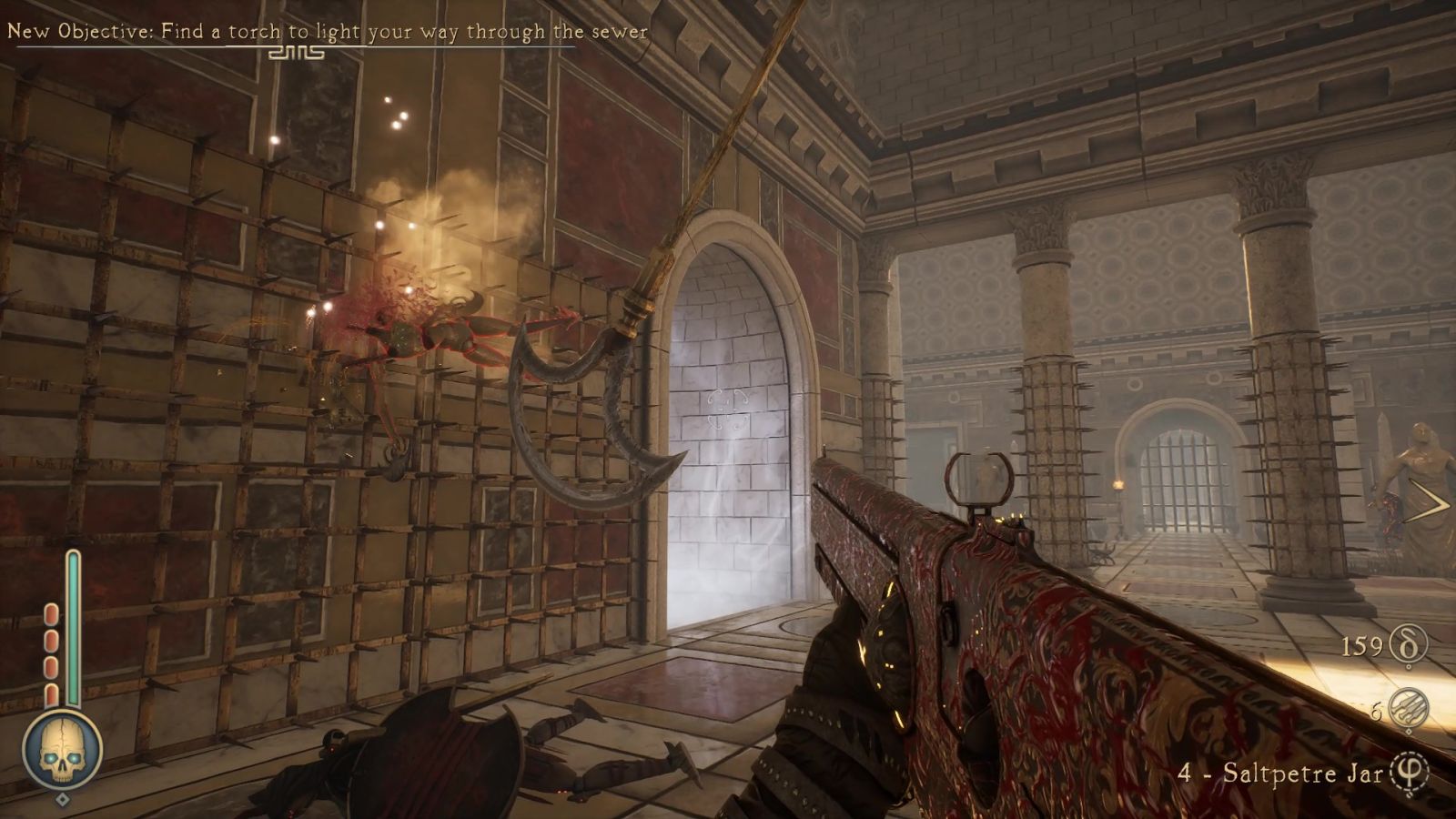
There are also some ranged enemies. One of which is a winged devil that fires a laser through a trumpet, the other, a cultist that fires magic missiles at you. The devils take some time to fly up to a certain altitude before they start firing. The cultists on the other hand spawn on the ground, and will try to aim their shots in the direction you’re moving, usually drastically overestimating where you’ll be. It’s pretty entertaining to watch them whiff their shots so drastically, but it would be nice if the devs dialed it back a bit. Another problem is that all enemies suffer from constant, random spawning. It’s especially bad for the ranged cultists, who can spawn a tad too close, meaning if you have a melee weapon, you have an awkward little staredown while you wait for them to cast their spell in order to dodge and retaliate. Enemies occasionally spawn behind you, which, in a game with only three hits before death, can be immensely irritating.
It’s important to note that the difficulty is customizable. You can change the levels of various difficulty factors in the gameplay menu, including: enemy hesitation, bullet hit radius, and aim assist. It really does allow the player to create the custom difficulty they enjoy the most. One tragedy is that enemy spawn rates are tied to difficulty presets, rather than being their own category. Perish will spam enemies at you constantly, and it seems to have no grasp on gameplay tempo.
Every time you spawn on a level, you’re given one of a handful of objectives to complete. These include: kill the monster, wait in the glowing circle, get the items, or, everyone’s favorite task, an escort mission. Upon completing these tasks, you’re given an upgrade card. It’s the system common in roguelikes and roguelites where you’re presented with three cards and get to choose one. For example, the perk “Dark Messiah” makes your kicking do more damage (although comparing this game’s kicking to Dark Messiah’s is sacrilege). You can find more cards throughout the levels, but all in all, there’s a rather underwhelming selection. One card is simply a “shuffle” card that gives you three different cards to choose from. I would have preferred they just had an interesting upgrade in that slot. One feature I really love about these cards is that if you die, you literally watch them burn away in front of you. It adds insult to injury at the end of a run.
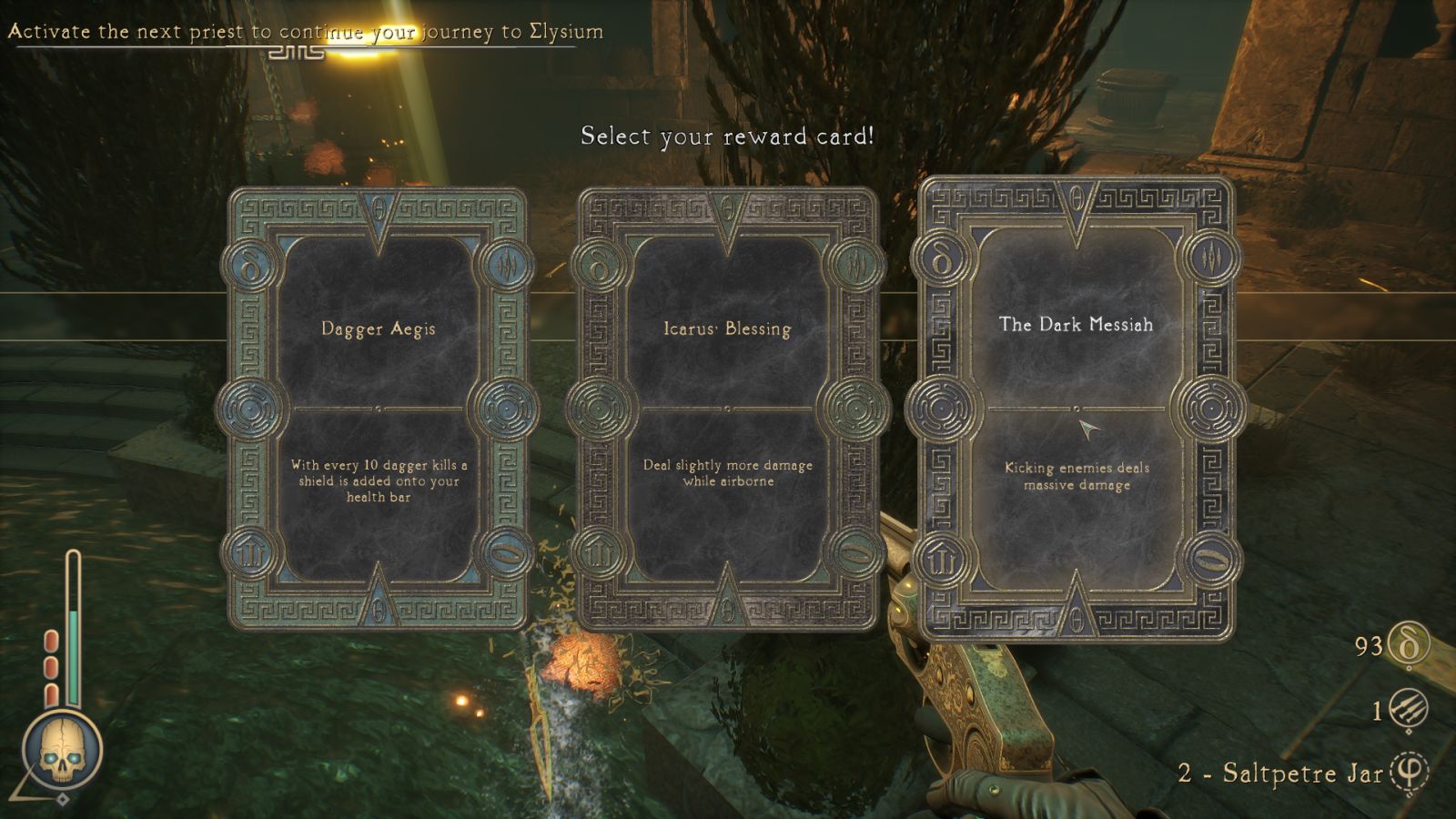
There are other ways to boost your stats, some of which are more permanent. You can buy rings, crowns, and equipment from the altar in the Pantheon. For example, you could get a ring that increases your dagger damage, or a crown that lets you skip an area entirely, and some equipment that provides a drop shield. On top of that, you can perform orphic rites, optional challenges that unlock new gear. There are also some cosmetics to buy in the shop, all of which look excellent.
Eventually, you’ll make it to an area of respite where you have a fountain to restore your health, a chest to change weapons, and a choice to make. Do you want to activate the statue and go to the next level, or go through the golden portal and back to the Pantheon? It might sound like an easy choice, but it’s complicated by the fact that you lose most of your money upon death, and returning home will stash your money. However, it will also reset your progress and remove your upgrade cards.
While I like how this choice gives players a dilemma to face, the rules set up for the golden portal aren’t always consistent. For example, there are a few times throughout the game where you will come across a golden portal that is essential for you to progress. It led to moments of “EHHHHHHH” where I felt apprehensive about entering the portal, because so far I’ve been taught that statues bring you to the next level, and golden portals take you home, thus killing your progress.
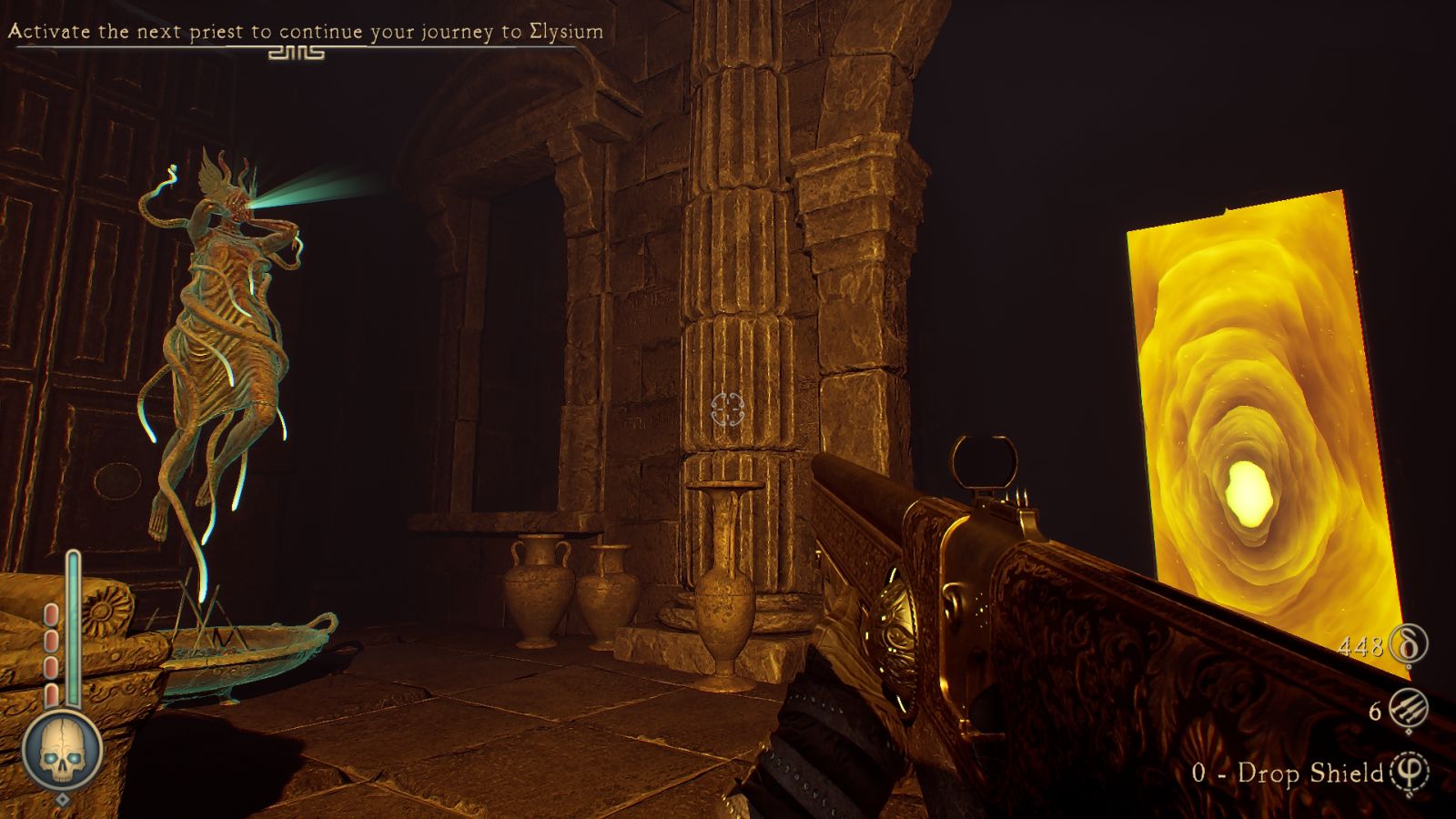
There’s a pretty good diversity of weapons, and the progression feels appropriately paced. You start with a broken sword and find additional weapons as you progress through the underworld, thus permanently unlocking them. It adds an incentive to explore beyond the various lore tidbits hidden throughout the map. Between unlocking and upgrading your weapons, you always feel like you’ve got something new and fun to play with coming soon. Speaking of upgrading your weapons, Perish uses a system where in order to upgrade your weapons, you have to actually use them. Every gun has a passive ability and an active ability that can be unlocked.
You’re given two challenges, something along the lines of “kill two enemies with one shot 30 times” or “kill multiple enemies with one swing 15 times.” It might be small, but I’ve played plenty of games where I unlock a weapon that I rarely use, and I passionlessly throw whatever in-game currency I’ve earned at them for upgrades just for the sake of completion. Needing to use the weapons and complete unique challenges in order to empower them means you gain a more intimate connection with your arsenal. However, there was one upgrade that threw me off. The sniper comes with excellent iron sights, but once you unlock the scope they get replaced entirely with no way to switch back.
There are balance problems among the weapons, however. For example, why would I use a sword when I can use the catholic big iron? Why would I use a revolver when I could use the burst fire rifle that fires a devastating laser for its special attack? The laser is so powerful that while charging up, the rifle shakes, like it can barely contain its own power, a superb detail that makes it feel all the more potent. Of course, most enemies are weak enough to be killed by a well placed headshot, but it seems like there’s clear winners and losers with your weapons. However, that’s just for the first half of the game, the meta skews even further later on.
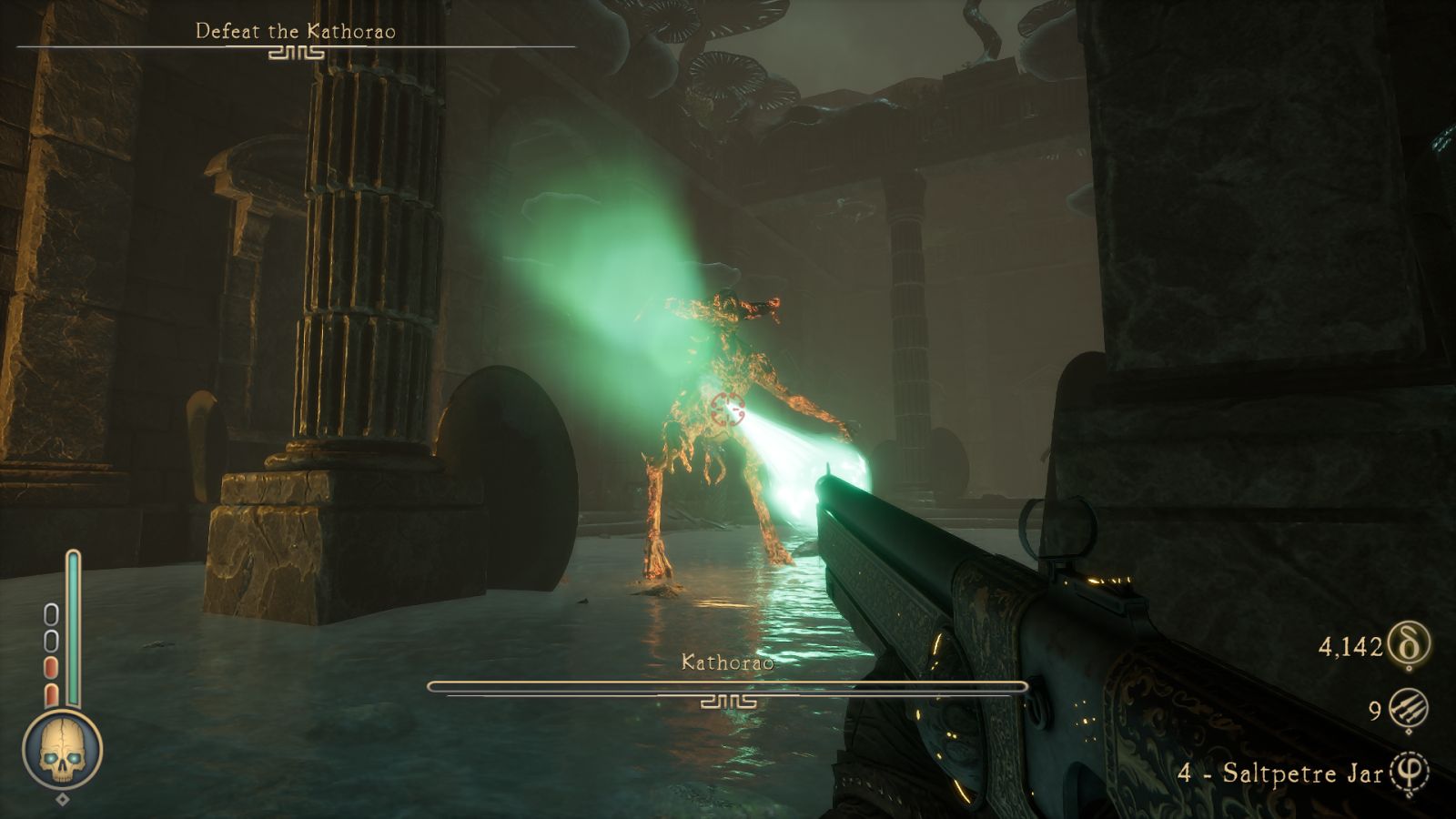
The first half of Perish is great, but the mid-late game drops the ball hard. Fighting enemies goes from feeling like a dance to feeling like a chore. Different game developers have different answers to the question, “How do we make the end game special and challenging for the player?” Perish answers with, “Tedious bosses and hunky crab men.” These crab men are called Kavouraki, and they’re TANKY. I had to fan the hammer, literally empty my gun 19 times on the Kavouraki in order to kill one. That would be fine, as they’re used as a miniboss, but towards the late game it just starts spawning them constantly.
They’re a harsh contrast to the enemies from the beginning of the game. With earlier enemies, you can smash through their shields, behead them, and target their weak parts, all of which feel impactful. The Kavouraki, on the other hand, offer no variation in combat strategy, making it unsatisfying to fight. It would have been great if parts of the chitin break away as you attack, revealing vulnerable bits, but it’s just a boring enemy performing the same attack over and over while you kite and shoot. It would be about as engaging to shoot a brick wall. On top of that, their design is… odd. They look like action figures, with abs, pauldrons, and highlighted joints. It really stands out in a sea of gritty enemies.

Of course, there are other issues with the mid-game. One boss was called the Phorcid, and it’s an extremely tedious fight with a chunky health bar, guardians that shield it from damage, and only one move it uses over and over, a flurry of knives. The boss fights in general are always interesting, bar the Phorcid, but they make the divide between melee and ranged weapons feel more palpable.
Another objective, the funeral procession, is just a long escort mission through a winding cave. You have to fend off Kavouraki and small crab enemies with horrific claymation-like movements that stand just below your vision and poison you, it’s quite the headache.
At the end, the cave leads to the sea, where you proceed to ignite and push the casket out to sea in a cathartic moment of calm after the fighting, you just watch it drift away… out of the mouth of the cave flanked by spears, and into the ocean. It’s as if you’re freeing them from the cycle of endless bloodshed that you yourself have yet to escape from. It truly is a beautiful moment… then the game spawns more enemies, because of course it does. There wasn’t even any objective to complete afterward, it just doesn’t know when to let a good moment play out.
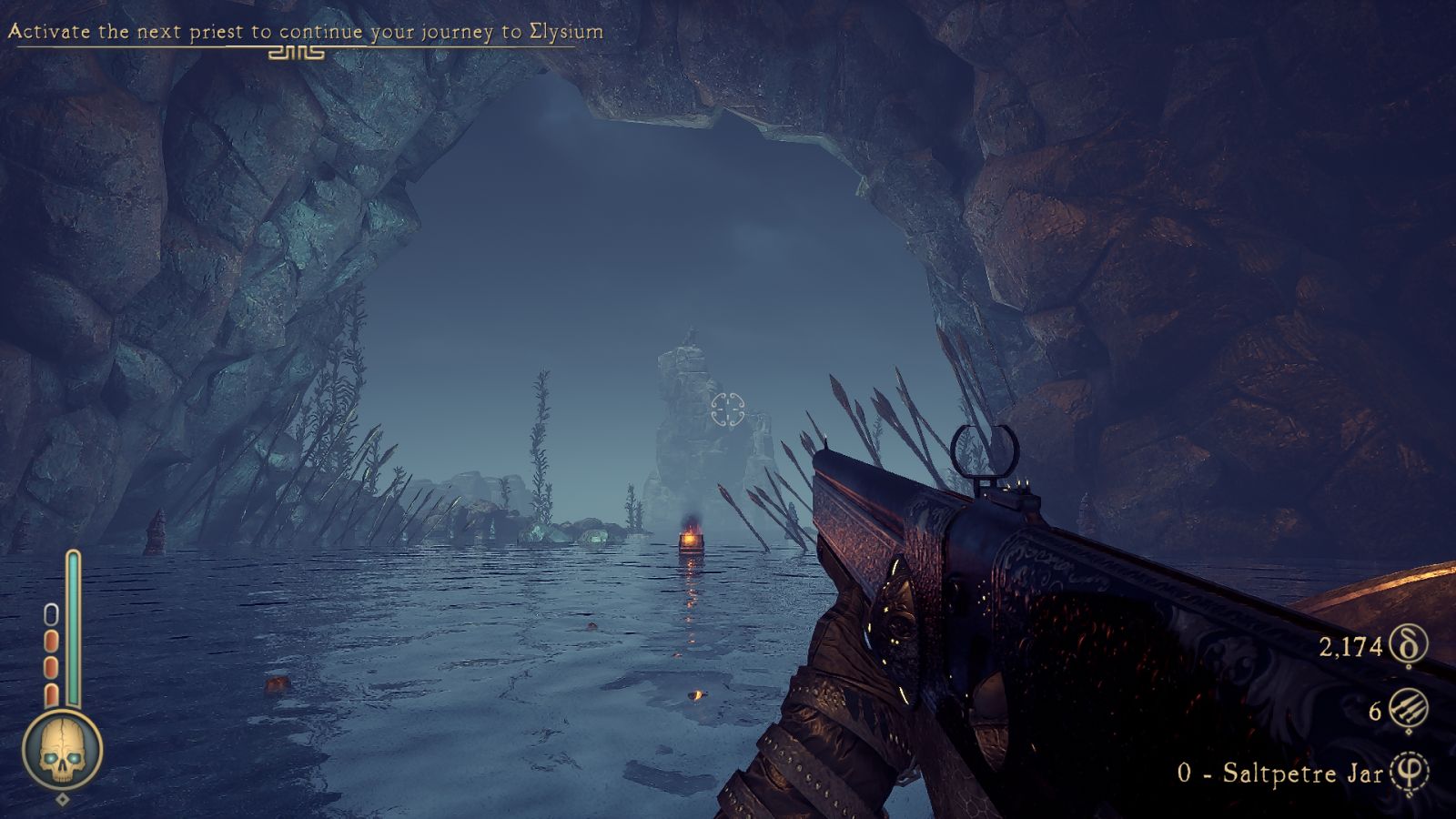
You then move onto an area that feels like it’s partially given up. A large field of floating rocks with Kavourakis, the small poison crabs, and the devils with their lasers. You topple massive statues to bridge the gap between platforms and use special lifts to launch yourself across the map; both features are quite unique and fun and add a sense of scale. It’s the only area in the game that I know of that doesn’t damage you for falling off the map. However, because of the enemy selection for this stage, it became boring almost immediately. Knowing I wouldn’t get hurt, I began jumping off the map to cover more distance, a little game that was more entertaining than the enemy selection the level offered. In what feels like a real kick in the teeth, after trudging through about half of the level, you come across a temple where your special task is to fight two Kavourakis at once, the same unengaging enemy you’ve been fighting for the last two levels.
While the midgame has its weaknesses, at the same time, it’s oozing with conceptual insanity. For example, take the Phorcid boss I mentioned. After you defeat it, you steal its bladder, place it into a fountain where it grows into a pearl that functions as a laser weapon, and then you shove that pearl into the eye of a statue to drain the water below and escape. Many quests are similar in insanity, it’s absolute madness, and I love it. Overall, while in the mid to late game, beware of lasers, crabs, and laser crabs.

The top-notch concepts translate well to the aesthetics of Perish. The art direction is grand yet detailed, like something out of Warhammer 40k. Massive statues and set pieces make you feel small, just one of the ways the game makes your journey and accomplishments feel larger. Zoom in a little bit, and even more is revealed. Upon glancing at the upgrade altar, it looks like the glyphs that embroider the tapestry are moving ever so slightly. The enemy design can also be quite intricate. On one of the levels, you fight biomachina, unholy fusions of flesh and machine. On one variation, you can see the fleshy tendrils dripping from the masks of the bronze-coded eldritch horrors.
The art direction for the weapons is also good. When you reload ranged weapons, you smack them, causing them to explode in white mist, making the reload feel punchy and otherworldly. From the tantalizing luster of the gold in the Pantheon and the furnished splendor of the mechanized palaces, to the more nature-oriented settings that are anything but natural, your eyes are in for a treat. The greatness goes beyond the visuals, as the soundtrack gets you hyped to duel some mythological monstrosities. I never thought I needed to hear metal with traditional Greek instruments, but now I know how badly I did. I was never once disappointed by it, and it really did elevate the game, especially the boss fights.

Perish is a multiplayer game, so feel free to grab up to three friends to blast away the hordes of the Greek underworld. It often seems like the game was directly made for multiplayer, as you can’t pause, even in single-player mode. It would also explain the unruly tank stats of the crab men. If you’re so inclined, then Perish is available on Steam, Epic Games Store, and GOG for $19.99. You can also buy the soundtrack to support the creators for $9.99, which I would say is well worth it for 25 banger tracks.
Perish
Good
Overall, Perish is a game that achieves conceptual brilliance and incorporates it down to the finest detail in many areas. Unfortunately, it stumbles when it comes to the execution. Some poor gameplay decisions hold it back, notably enemy design and spawn rates. It’s entirely possible that with future updates, the game will heal its scars, but for now, they run deep, blemishing the gameplay; yet, the aesthetics remain immaculate.
Pros
- Plenty of interesting weapons
- Great art direction
- Customizable difficulty
Cons
- Mid-Late game is a slog
- Limited pool of upgrade cards
- Poor enemy variety
